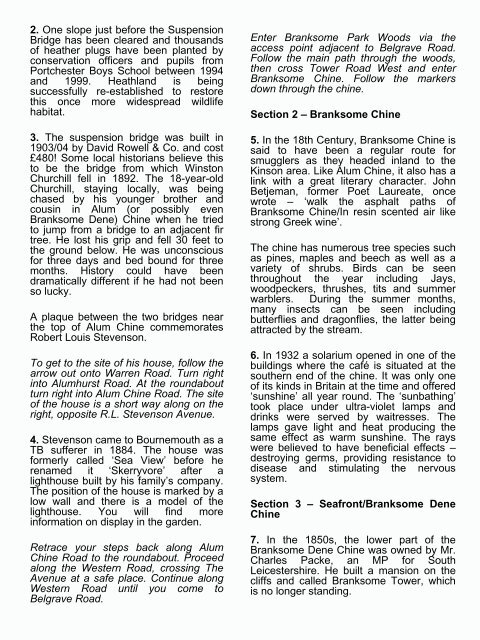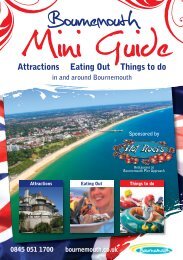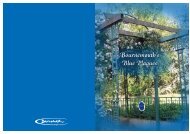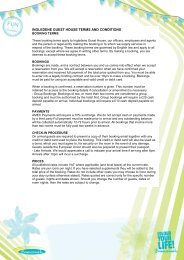The Chines of Bournemouth and Poole
The Chines of Bournemouth and Poole
The Chines of Bournemouth and Poole
Create successful ePaper yourself
Turn your PDF publications into a flip-book with our unique Google optimized e-Paper software.
2. One slope just before the Suspension<br />
Bridge has been cleared <strong>and</strong> thous<strong>and</strong>s<br />
<strong>of</strong> heather plugs have been planted by<br />
conservation <strong>of</strong>ficers <strong>and</strong> pupils from<br />
Portchester Boys School between 1994<br />
<strong>and</strong> 1999. Heathl<strong>and</strong> is being<br />
successfully re-established to restore<br />
this once more widespread wildlife<br />
habitat.<br />
3. <strong>The</strong> suspension bridge was built in<br />
1903/04 by David Rowell & Co. <strong>and</strong> cost<br />
£480! Some local historians believe this<br />
to be the bridge from which Winston<br />
Churchill fell in 1892. <strong>The</strong> 18-year-old<br />
Churchill, staying locally, was being<br />
chased by his younger brother <strong>and</strong><br />
cousin in Alum (or possibly even<br />
Branksome Dene) Chine when he tried<br />
to jump from a bridge to an adjacent fir<br />
tree. He lost his grip <strong>and</strong> fell 30 feet to<br />
the ground below. He was unconscious<br />
for three days <strong>and</strong> bed bound for three<br />
months. History could have been<br />
dramatically different if he had not been<br />
so lucky.<br />
A plaque between the two bridges near<br />
the top <strong>of</strong> Alum Chine commemorates<br />
Robert Louis Stevenson.<br />
To get to the site <strong>of</strong> his house, follow the<br />
arrow out onto Warren Road. Turn right<br />
into Alumhurst Road. At the roundabout<br />
turn right into Alum Chine Road. <strong>The</strong> site<br />
<strong>of</strong> the house is a short way along on the<br />
right, opposite R.L. Stevenson Avenue.<br />
4. Stevenson came to <strong>Bournemouth</strong> as a<br />
TB sufferer in 1884. <strong>The</strong> house was<br />
formerly called ‘Sea View’ before he<br />
renamed it ‘Skerryvore’ after a<br />
lighthouse built by his family’s company.<br />
<strong>The</strong> position <strong>of</strong> the house is marked by a<br />
low wall <strong>and</strong> there is a model <strong>of</strong> the<br />
lighthouse. You will find more<br />
information on display in the garden.<br />
Retrace your steps back along Alum<br />
Chine Road to the roundabout. Proceed<br />
along the Western Road, crossing <strong>The</strong><br />
Avenue at a safe place. Continue along<br />
Western Road until you come to<br />
Belgrave Road.<br />
Enter Branksome Park Woods via the<br />
access point adjacent to Belgrave Road.<br />
Follow the main path through the woods,<br />
then cross Tower Road West <strong>and</strong> enter<br />
Branksome Chine. Follow the markers<br />
down through the chine.<br />
Section 2 – Branksome Chine<br />
5. In the 18th Century, Branksome Chine is<br />
said to have been a regular route for<br />
smugglers as they headed inl<strong>and</strong> to the<br />
Kinson area. Like Alum Chine, it also has a<br />
link with a great literary character. John<br />
Betjeman, former Poet Laureate, once<br />
wrote – ‘walk the asphalt paths <strong>of</strong><br />
Branksome Chine/In resin scented air like<br />
strong Greek wine’.<br />
<strong>The</strong> chine has numerous tree species such<br />
as pines, maples <strong>and</strong> beech as well as a<br />
variety <strong>of</strong> shrubs. Birds can be seen<br />
throughout the year including Jays,<br />
woodpeckers, thrushes, tits <strong>and</strong> summer<br />
warblers. During the summer months,<br />
many insects can be seen including<br />
butterflies <strong>and</strong> dragonflies, the latter being<br />
attracted by the stream.<br />
6. In 1932 a solarium opened in one <strong>of</strong> the<br />
buildings where the café is situated at the<br />
southern end <strong>of</strong> the chine. It was only one<br />
<strong>of</strong> its kinds in Britain at the time <strong>and</strong> <strong>of</strong>fered<br />
‘sunshine’ all year round. <strong>The</strong> ‘sunbathing’<br />
took place under ultra-violet lamps <strong>and</strong><br />
drinks were served by waitresses. <strong>The</strong><br />
lamps gave light <strong>and</strong> heat producing the<br />
same effect as warm sunshine. <strong>The</strong> rays<br />
were believed to have beneficial effects –<br />
destroying germs, providing resistance to<br />
disease <strong>and</strong> stimulating the nervous<br />
system.<br />
Section 3 – Seafront/Branksome Dene<br />
Chine<br />
7. In the 1850s, the lower part <strong>of</strong> the<br />
Branksome Dene Chine was owned by Mr.<br />
Charles Packe, an MP for South<br />
Leicestershire. He built a mansion on the<br />
cliffs <strong>and</strong> called Branksome Tower, which<br />
is no longer st<strong>and</strong>ing.
















